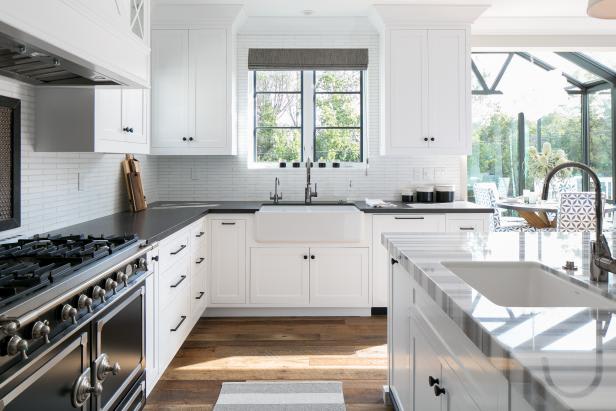Getting Ready to Sell Your Home: A Comprehensive Guide
Selling your home is a significant undertaking, and proper preparation is key to ensuring a successful sale. In this comprehensive guide, we'll walk you through a detailed roadmap for getting your home ready for the market. By following these steps, you'll not only maximize your property's appeal but also increase your chances of a quick and lucrative sale.
Declutter and Depersonalize: Creating the Perfect Canvas
One of the fundamental steps in preparing your home for sale is decluttering and depersonalizing your living spaces. This process involves much more than just tidying up; it's about creating a neutral backdrop that allows potential buyers to envision themselves in your property. Here's how to do it effectively:
1. Start by removing excess items and personal belongings
Begin the process of preparing your home for sale by carefully assessing each room. Identify items that can be removed to create a cleaner, more open space. Personal items like framed photos, bulletin boards, and excessive decorations should be the first to go. While these items hold sentimental value to you, they can make it challenging for potential buyers to imagine themselves in the space. Leave a few tasteful framed photos to maintain a welcoming ambiance without overwhelming the environment.
2. Streamline your furniture and decor
Examine each room's layout and consider whether there's excess furniture or decor that can be removed to make the space feel more open and inviting. A clutter-free home not only looks more spacious but also allows buyers to focus on the property itself rather than being distracted by unnecessary items. Consider renting a storage unit to temporarily store belongings that you don't need while your home is on the market. This not only helps declutter your living spaces but also makes the eventual moving process more manageable.
Consult a Handyman: Ensuring Your Home is in Top Shape
A well-maintained home sends a strong message to potential buyers that your property has been cared for and is in good condition. It's essential to address any needed repairs promptly before listing your home. Here's what you should consider:
1. Keep a reliable handyman on standby
Home maintenance and repairs can arise at any time, so it's wise to have a reliable handyman or contractor available to address various issues. From fixing locks, hardware, and leaky faucets to addressing squeaky doors and running toilets, a well-functioning home conveys a sense of quality and care to potential buyers.
2. Conduct a comprehensive home inspection
Before listing your home, invest in a thorough home inspection. This proactive approach allows you to identify and address any significant issues before buyers hire their inspectors. By addressing potential problems upfront, you can present your home as move-in ready, reducing potential buyer concerns and streamlining the selling process.
Conduct a Thorough Cleaning: Presenting a Pristine Home
A spotless home is not only visually appealing but also essential in making a positive impression on potential buyers. Keeping your home impeccably clean throughout the selling process is crucial. Here's how to achieve it:
1. A deep clean from top to bottom
Devote time to cleaning every inch of your home, paying particular attention to high-traffic areas and spaces that tend to accumulate dirt and grime. This includes cleaning toilets, sanitizing surfaces, deep-cleaning floors, and refreshing rugs. A clean home not only looks more inviting but also gives the impression that it has been well cared for.
2. Consider professional cleaning services
For an exceptionally thorough and impeccable cleaning job, consider hiring professional cleaning services. Experienced cleaners have the expertise and specialized equipment to achieve a level of cleanliness that may be challenging to attain on your own. Their attention to detail can make a significant difference in the overall presentation of your home.
3. Exterior maintenance matters
Don't overlook the exterior of your home. Ensure that the outside of your property is well-maintained, with a manicured lawn, trimmed landscaping, and a clean, appealing facade. First impressions matter, and the exterior is the first thing potential buyers see when they arrive for a showing.
Freshen Up with Paint: Creating a Blank Canvas
Painting your home can be one of the most cost-effective ways to freshen up its appearance and make it more appealing to buyers. When done right, a fresh coat of paint can transform your space and conceal imperfections. Here's what you need to know:
1. Choose neutral colors for your walls
Opt for neutral colors like whites, light grays, soft beiges, and greige for your interior walls. These shades create a sense of spaciousness and brightness, making it easier for buyers to envision their furniture and decor in the space. Neutral colors provide a clean and versatile backdrop that appeals to a broader range of tastes.
2. Address imperfections before painting
Before painting, inspect your walls for any imperfections, such as cracks, holes, or chipped paint. Repair these issues before applying a fresh coat of paint to ensure a smooth and flawless finish.
3. Consider exterior painting
If your home's exterior paint is worn or faded, consider repainting it to improve your home's curb appeal. A fresh coat of exterior paint can make your property more attractive to potential buyers, enticing them to explore further.
If Needed, Secure a Storage Unit: Clearing the Way
As you declutter and depersonalize your home, you may find that you have a significant number of items to temporarily remove from your living spaces. Renting a storage unit can be a practical solution to store excess belongings while you showcase your property to potential buyers. Here's how to make the most of this strategy:
1. Choose the right storage unit
Select a storage unit that is conveniently located and appropriately sized to accommodate your belongings. Many storage facilities offer a range of unit sizes to suit different needs.
2. Organize and label your stored items
Pack your items in sturdy boxes and containers, and label them clearly for easy retrieval when you move to your new home. Organize your storage unit logically, with items you're less likely to need toward the back and those you may access more frequently near the front.
3. Focus on minimizing clutter
When selecting items to store, concentrate on minimizing clutter and creating a clean and organized living environment in your home. This will not only enhance the visual appeal of your property but also make it easier for potential buyers to navigate and envision the space.
Depersonalize Your Living Spaces: Striking the Right Balance
While depersonalizing your home is essential to help potential buyers envision themselves living in the space, it's also crucial to strike a balance and maintain a warm and inviting atmosphere. Here are some tips for achieving this delicate equilibrium:
1. Store most framed photos and personal items
Put away most framed photos, bulletin boards, and personal items like photo albums, magazines, toys, and awards throughout your home. The goal is to remove personal elements that might distract buyers while preserving a welcoming ambiance.
2. Maintain a lived-in feel
Leave a few tasteful framed photos and decorative items strategically placed around the house. These can help make your home feel inviting and lived-in without overwhelming buyers with personal artifacts.
3. Update your decor with neutral elements
Consider updating your decor with neutral and universally appealing elements. Fresh, neutral throw pillows, bedding, and artwork can make your home feel more contemporary and appealing to a broader range of buyers.
Hire a Professional Photographer: Capturing Your Home's Best Angles
In today's digital age, high-quality, professional photographs are essential for showcasing your home effectively online. Online listings are often the first point of contact for potential buyers, making visual presentation paramount. Here's what you should consider when hiring a professional photographer to capture your home's best angles:
1. Experience and Portfolio
Look for a photographer with experience in real estate photography. Review their portfolio to ensure they have a track record of capturing homes in an appealing and compelling manner.
2. Equipment
A professional photographer should have the right equipment, including high-resolution cameras, wide-angle lenses, and proper lighting gear. This equipment ensures that your property is showcased in the best possible light.
3. Staging Assistance
Some photographers offer staging assistance, helping you arrange furniture and decor to optimize each room's appeal. This can be particularly valuable in creating visually appealing photos.
4. Timing and Lighting
Discuss the best time of day for the photo shoot to maximize natural light. Proper lighting can significantly enhance the overall quality of the photographs.
5. Editing and Enhancement
Inquire about their post-processing techniques. Professional photographers often enhance and edit images to ensure they look their best, removing minor imperfections and optimizing colors.
6. Virtual Tours and Drone Photography
Consider additional services such as virtual tours and drone photography if they suit your property. Virtual tours provide an immersive experience for online viewers, while aerial shots can showcase your property and its surroundings from unique angles.
Remember that the investment in professional photography is well worth it, as it can greatly enhance your online listing and attract more potential buyers to your property. Stunning visuals can be the difference between a quick sale and a property that lingers on the market.
Enhance Your Home's Curb Appeal: First Impressions Matter
The exterior of your home is the first thing potential buyers see when they arrive for a showing. A well-maintained and inviting exterior can create a positive first impression and set the stage for a successful viewing. Here's how to enhance your home's curb appeal:
1. Landscaping and Lawn Care
Invest time in landscaping and lawn care to ensure your property looks its best. Trim bushes and trees, weed flower beds, and add fresh mulch for a polished appearance. Regularly mow and edge your lawn to maintain a manicured look.
2. Front Door and Entryway
Your front door is a focal point. Ensure it's in good condition with a fresh coat of paint if needed. Consider adding a new welcome mat and potted plants to create an inviting entryway.
3. Exterior Cleaning
Power wash the exterior of your home to remove dirt, grime, and mildew. This simple step can make your property look significantly cleaner and more appealing.
4. Outdoor Lighting
Good outdoor lighting not only enhances safety but also adds charm to your home. Ensure that all outdoor lights are functioning correctly, and consider adding lighting to highlight architectural features or landscaping.
5. Repairs and Maintenance
Inspect the exterior of your home for any needed repairs. Fix loose siding, replace missing roof shingles, and repair or replace damaged gutters and downspouts. These small but essential details can make a big difference.
6. Street View
Walk across the street and take a critical look at your home. Consider what potential buyers will see when they first approach. Is the house inviting? Does it stand out in a positive way? Address any issues that might detract from its overall appeal.
Set the Right Price: A Competitive Market Analysis
Pricing your home competitively is crucial for attracting potential buyers. An overpriced home can deter buyers, while an underpriced one can lead to missed opportunities. Here's how to set the right price:
1. Research Comparable Properties
Perform a thorough analysis of recently sold homes in your neighborhood that are similar in size, condition, and features to your property. This will give you a benchmark for pricing your home competitively.
2. Consult a Real Estate Agent
Enlist the help of a knowledgeable real estate agent who can provide valuable insights into the local market. They can help you interpret market trends, assess your home's unique features, and recommend an appropriate listing price.
3. Consider Market Conditions
Take into account current market conditions. In a seller's market, where demand exceeds supply, you may be able to set a slightly higher price. In a buyer's market, where there are more homes available than buyers, pricing competitively is essential.
4. Avoid Overpricing
While it's natural to want to maximize your return, overpricing your home can lead to it languishing on the market. Many buyers filter search results based on price, so pricing slightly below your target can attract more interest.
5. Price Adjustments
Be prepared to make price adjustments if your home doesn't receive offers within a reasonable timeframe. Your real estate agent can advise you on when and how to make these adjustments to keep your listing competitive.
Professional Home Staging: Presenting Your Home at Its Best
Professional home staging involves arranging and decorating your home to highlight its best features and create an inviting atmosphere for potential buyers. While it's an optional step, it can significantly impact how buyers perceive your property. Here's what you should know about home staging:
1. The Benefits of Home Staging
Staged homes often sell faster and at higher prices than their unstaged counterparts. Staging can help buyers envision themselves living in the space, making your home more appealing.
2. DIY Staging vs. Hiring a Professional
You can choose to stage your home yourself or hire a professional stager. Professional stagers have experience and expertise in maximizing your home's appeal, but if you opt for DIY staging, focus on decluttering, depersonalizing, and arranging furniture to create an open, inviting flow.
3. Staging Tips
- Neutral Decor: Use neutral colors for decor and furnishings to appeal to a broader range of tastes.
- Declutter: Keep surfaces clear and minimize personal items to create a clean, open feel.
- Furniture Arrangement: Arrange furniture to showcase each room's purpose and maximize space.
- Curb Appeal: Apply staging principles to your home's exterior as well. Ensure landscaping is well-kept and that the entrance is welcoming.
Create an Appealing Listing: Online and In Print
Creating an appealing listing is essential to attract potential buyers. Your listing is often the first impression buyers have of your home, so make it count. Here's how:
1. High-Quality Photos
Invest in high-quality, professional photographs of your home. These images should showcase your property's best angles and features. Consider including both interior and exterior shots, as well as images of any special amenities.
2. Detailed Property Description
Write a detailed property description that highlights your home's unique features and benefits. Mention recent upgrades, energy-efficient features, and any outstanding amenities your neighborhood offers.
3. Clear and Informative
Ensure that your listing provides essential information, including the number of bedrooms and bathrooms, square footage, lot size, and any relevant details about the property's history, such as recent renovations or improvements.
4. Online and Print Marketing
Leverage both online and print marketing channels to reach a broader audience. Your real estate agent can help create an effective marketing strategy that includes listing your home on popular real estate websites, social media, and local publications.
5. Virtual Tours and 3D Walkthroughs
Consider offering virtual tours or 3D walkthroughs as part of your listing. These immersive experiences allow potential buyers to explore your home online, increasing their engagement and interest.
Prepare for Showings: Making a Positive Impression
Once your home is listed, showings are an integral part of the selling process. Here's how to prepare for successful showings:
1. Maintain Cleanliness
Keep your home in impeccable condition throughout the showing process. Clean and tidy up before each showing to create a welcoming environment for potential buyers.
2. Be Flexible with Showings
Be accommodating with showing requests, even if they fall outside regular hours. The more accessible your home is for showings, the more opportunities you have to attract potential buyers.
3. Leave During Showings
Give potential buyers space during showings. It's essential to allow them to explore your home comfortably and discuss their impressions openly with their agent.
4. Highlight Key Features
Leave notes or brochures highlighting key features, recent upgrades, and any additional information that could be beneficial to potential buyers.
5. Secure Valuables
During showings, secure any valuable or personal items. While most potential buyers are respectful, it's best to take precautions.
Consider Pre-Inspections: Addressing Concerns Upfront
Pre-inspections involve hiring a home inspector to assess your property before listing it for sale. While it's not always necessary, pre-inspections can provide several advantages:
1. Identify and Address Issues
A pre-inspection allows you to identify and address any potential issues before potential buyers hire their inspectors. Addressing concerns upfront can lead to a smoother and less stressful selling process.
2. Build Trust with Buyers
Sharing the results of a pre-inspection with potential buyers can build trust. It demonstrates transparency and shows that you've taken steps to ensure your home is in good condition.
3. Avoid Surprises
A pre-inspection can help you avoid surprises during the selling process. By being aware of any issues beforehand, you can make informed decisions and avoid last-minute negotiations or delays.
Negotiate Offers: Securing the Best Deal
When offers start coming in, it's essential to negotiate effectively to secure the best deal for your home. Here are some negotiation tips:
1. Be Open to Offers
Consider all offers seriously, even if they're not exactly what you were hoping for. Be open to negotiation and willing to work with buyers to reach a mutually beneficial agreement.
2. Understand Market Trends
Your real estate agent can provide valuable insights into current market trends and the strength of different offers. Use this information to make informed decisions during negotiations.
3. Counteroffers
Don't hesitate to make counteroffers if an initial offer isn't quite right. Counteroffers are a standard part of the negotiation process and can lead to a successful agreement.
4. Be Patient
Negotiations can take time, so be patient throughout the process. Avoid making hasty decisions out of frustration.
Complete the Closing Process: Finalizing the Sale
Once you've accepted an offer, you'll move into the closing process. Here's what to expect during this phase:
1. Home Appraisal
A home appraisal is typically ordered by the buyer's lender to determine the property's fair market value. Be prepared for the possibility that the appraisal may come in lower than the agreed-upon sale price. Your real estate agent can guide you through potential next steps.
2. Home Inspection
The buyer will likely schedule a home inspection to assess the property's condition and identify any issues. Depending on the inspection results, negotiations may resume to address necessary repairs or adjustments to the sale price.
3. Title Search and Insurance
A title search will be conducted to ensure there are no outstanding liens or ownership disputes on the property. Additionally, title insurance is typically purchased to protect the buyer and lender in case of unforeseen title issues.
4. Closing Costs
Both the buyer and seller will incur closing costs, which cover various fees associated with the sale. These costs can include agent commissions, title insurance, recording fees, and more. Your real estate agent can provide a breakdown of expected closing costs.
5. Final Walkthrough
Before the closing, the buyer will usually conduct a final walkthrough of the property to ensure it's in the same condition as when the offer was accepted and that any agreed-upon repairs have been completed.
6. Signing and Funding
The closing typically involves signing numerous documents, including the settlement statement, loan documents (if applicable), and the deed. Once all documents are signed and funds are transferred, the sale is considered complete.
Conclusion: A Successful Sale
Getting ready to sell your home is a comprehensive process that involves numerous steps and careful planning. By decluttering and depersonalizing your living spaces, addressing necessary repairs, conducting a thorough cleaning, and presenting your home in the best possible light, you can maximize its appeal to potential buyers. Additionally, working with experienced professionals, including real estate agents and photographers, can significantly enhance your chances of a quick and lucrative sale.
Remember that each step in the process plays a crucial role in creating a positive impression on potential buyers and streamlining the selling process. From preparing your home's interior and exterior to setting the right price, staging effectively, and negotiating offers, attention to detail can lead to a successful sale and a seamless transition to your next home.




